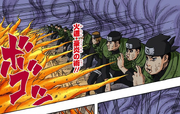| Sarutobi Clan | |||
|---|---|---|---|
| File:Sarutobi Symbol 2.svg | |||
| (猿飛一族, Sarutobi Ichizoku) | |||
| Debut | |||
| Appears in | Anime, Manga, Game, Movie | ||
| Clan Data | |||
| Affiliation | |||
| |||
| |||
The Sarutobi clan (猿飛一族, Sarutobi Ichizoku) is an influential clan from Konohagakure. It has produced several notable members who have held positions of high authority, including the Third Hokage, and membership in the Twelve Guardian Ninja. All known members have also been observed devotees of the Will of Fire.
Overview

Members of the Sarutobi clan.
After Konohagakure's formation following the Warring States Period, the Sarutobi were amongst the first set of clans to ally themselves with the Senju and Uchiha-founded village, alongside the Shimura clan.[1] Not much is known of this clan but, in order to strengthen the unity between the Akimichi, Nara, and Yamanaka clans, it has become a tradition that one of the Sarutobi give each of the members of the current Ino–Shika–Chō trio special earrings when they swear their oaths.[2] Several members were also seen during the Fourth Shinobi World War in the battle against Madara, Obito Uchiha, and the Ten-Tails. They used the Fire Release: Great Flame Technique to quickly dry the quicklime which was covering the beast.[3]
Abilities
The Sarutobi are famous for their high willpower, and exceptional strength. The clan also uses hiden ninjutsu involving the Fire Release nature transformation.[4]
Other Notable Clan Members
- During the Fourth Shinobi World War, a group of Sarutobi clan members attacked the Ten-Tails by super-heating the cement-like substance which the beast had been trapped in.[3]
Trivia
- Sarutobi means 'monkey jump': 'Saru' (猿) is the character for 'monkey', and "Tobi" (飛) is the character for "jump".
- The clan name 'Sarutobi' (as well the name of Hiruzen's father) comes from the famous ninja, Sarutobi Sasuke.
- Sasuke Uchiha was given the name of one of the clan's members in the hope that he would grow up to be a great shinobi just like him.[5]
